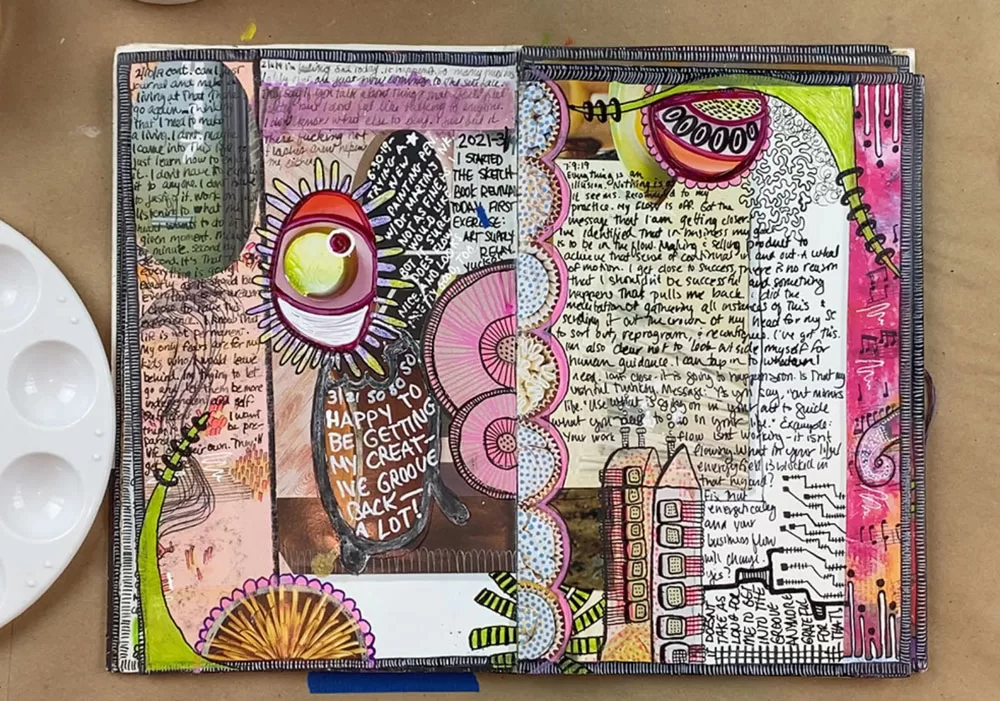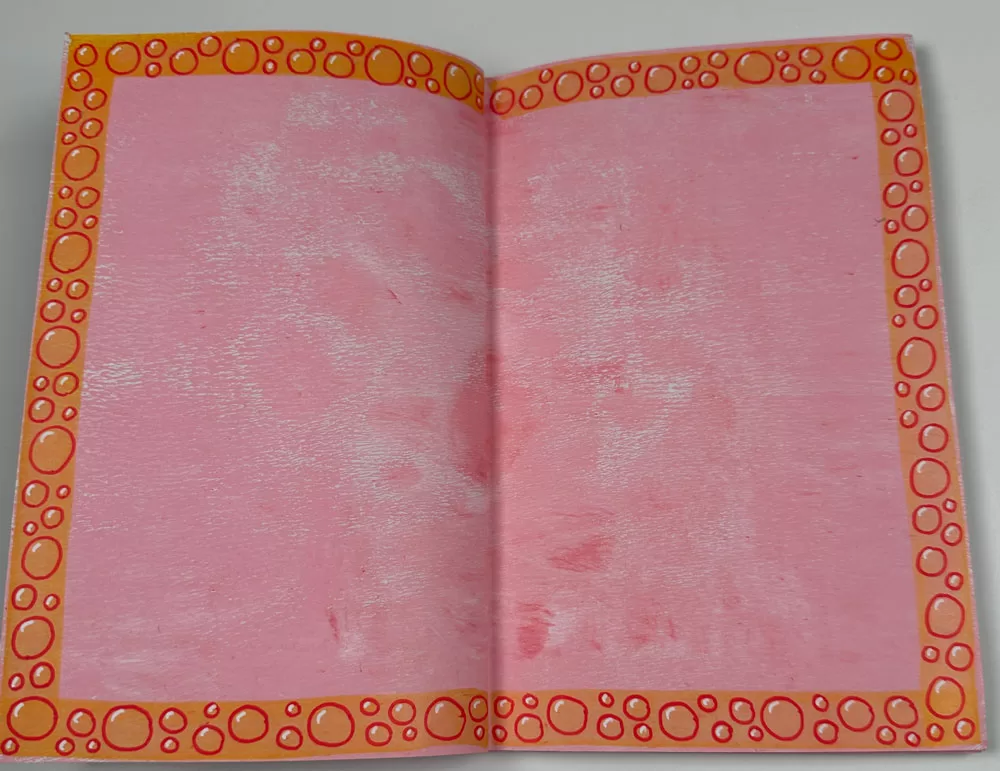Art journaling might seem like a fancy term reserved for those with a natural gift for creativity, but that’s a myth that needs busting right now.
Myth One: Not everyone is creative

First off, everyone is creative in their unique way.
Think about it: Have you ever whipped up a meal with just a handful of ingredients? Solved a problem at work in a clever way? Those everyday acts are creativity in action.
Art journaling is no different. It’s about problem-solving, making choices, and finding solutions. If you’ve ever found a workaround in daily life, you’re already on your way to being great at art journaling.
Kickstart your Art Journaling Journey
To rediscover your creative spark, start by observing the world around you with all your senses.
Notice the colors, sounds, textures, tastes, and smells. This heightened awareness will open your eyes to the beauty around you, fueling your creativity.
Have you ever wondered how painters make such inspiring works, or how photographers capture such great images? Their eyes are trained to see the world differently, and that is what you need to do.
You can do this exercise anywhere, anytime. Do it as often as you can remember.
Next, jot down your observations, feelings, and any ideas in an art journal. Take notice of how you feel, and any awarenesses that arise because of it.
- Does it make you feel anxious, or calm?
- Is it hard? Does it get easier? Does it come to you naturally?
- How distracted do you get? Can you come back to it?
- Did you notice any changes in your thoughts or actions?
- Note anything else.
- Do mindful exercises like noticing how your bare feet feel as you walk, or how the pen feels as it drags across the paper.
Do this for at least a week. Longer is better, until you start noticing yourself doing it without having to think about it. Ideally, you will start to see the world this way all the time, effortlessly.

Myth Two: You need expensive supplies
You don’t need fancy tools to start art journaling. Anything from old books, paper bags, and even recycled materials can serve as your canvas.
My Jumble Journal Method embraces using what you have, turning everyday items into art. This approach not only saves money but also sparks creativity in using unconventional materials.
Have you ever heard of junk journaling? It’s where you take all kinds of stuff that would normally end up in the landfill and turn it into a cool book that you can either use for a daily journal, or just as an art piece to work on.
When my great-aunt died we found piles of old wallpaper sample books stacked in her farmhouse attic. She had used them to collage in newspaper clippings, photos, and foldouts of detailed family trees that she’d maintained, that dated back to the 1800s.
Even though that was all she had to work with, ohmygosh, they were amazing! Art journaling can be done the same way.
Examples of Free Materials and Supplies You Can Use:
- Old books, as with the wallpaper sample books, can be used as art journals. Just work on top of the pages.
- Discarded paper grocery bags or paper shopping bags can be used for inner pages.
- Coffee, tea, dirt, or any other colored liquid can be used as a stain for aging, weathering, and colorizing pages or portions of pages.
- Discarded food boxes, like cereal boxes can be used as the base for covers.
- Any tape or glue you already have on hand can work for attaching collage.
- Old magazines, catalogs, greeting cards, business cards, postcards, junk mail, etc, can be used in various ways for collage or other elements.
- Any supplies you already have on hand from previous projects, including school and office supplies. You’d be amazed at what you can do with pencils, pens, and markers that you have lying around.
When I use my Jumble Journal Method I regularly turn to these free materials. I feel satisfaction that I’m saving a little bit from the landfill, and saving money that I can use on other things that can’t be found free.
If you start looking at things around you differently (as suggested in myth number one) you’ll see all kinds of things around you that can be incorporated into your journaling.

Myth Number Three: It has to be perfect
Art journaling isn’t about creating masterpieces; it’s about expression and exploration.
If the fear of not being “good enough” holds you back, it’s time to let go. Art journaling is a personal space for you to experiment, make mistakes, and grow. No one needs to see it unless you choose to share.
There is no such thing as perfect when it comes to journaling, or art. Or anything, for that matter.
Think about it: Art JOURNALING.
Journaling is meant to be a personal process to write out your thoughts–a diary. I don’t know many people that would say that a diary needs to be perfect. WE are not perfect, so the expression of ourselves therefore, should not be perfect.
The problem comes in when we add that dirty little word, “art” to the journaling process. Those three letters throw us right back to Myth Number One, where we start judging our product, and ourselves, and our abilities.
Remember: art journaling is a place to explore and experiment, to try new things, and to express yourself.
No one needs to see it. Heck, you don’t ever have to go back and look if you don’t want to.
What to do if you find yourself overwhelmed by perfectionism
- Just say no
Seriously. Have a literal conversation with your inner critic and tell it to hit the road. Maybe even write it out in your journal. I totally do that in my warm-up journal. You can let it come back later, but there is no room for it while you’re in your journal. - Just do it
Remind yourself that you have every other minute of the day to be perfect. Dip your toe into the pool of uncertainty and push yourself to break through the desire, even just a little bit, in this moment, right now. - Think different
Do the opposite of what you’re feeling compelled to do. You may not like the outcome at first, but the more you practice stepping outside of your box, the sooner you will start to feel more free Once you get comfortable with that, precision will be a choice, and not as much of a compulsion. - So easy a caveman can do it
Simplify. Stop trying to be so fancy and comphrehensive, having to know and do all the things. Go back to basics. Sometimes we make things more complicated that they need to be. Rather than looking too far ahead at what you want it to be, take a step back and focus on what is in front of you…the next line or small section.

Myth Four: You must finish before starting a new one
It’s okay to have multiple journals in progress.
This practice allows you to work according to your mood and interest without the pressure of completion. Each journal can serve a different purpose, whether it’s for warm-ups, travel memories, or inspiration.
The beauty of art journaling lies in its flexibility and the freedom to explore various themes and ideas.
Not finishing is totally OK when it comes to art journaling. In fact, it’s encouraged.
If you feel like you have to finish one journal before starting a new one you will inevitably come up against a wall where you feel like you’re forcing yourself to do something that you don’t want to.
Ask yourself why something unfinished is so uncomfortable for you. Then take some time to drill deeper into that belief.
- Was it a family value you learned?
- Do you feel inadequate in some way if you leave something open-ended?
- Does this belief help to serve or hinder you, or both?
- What would your life look like if you could leave an art project on-going and unfinished indefinitely?
As my fourth grader teacher used to say, “P-shaw!”
Life’s too short to keep yourself in limiting boxes! Jump around and have all the journals you want going at the same time. They look pretty cool when they’re all stacked up, and fun to flip through while you decide which one to work in next.
Benefits of multiple ongoing, unfinished journals
- You always have something ready to work on.
- You don’t have to plan and start a new project.
- You can work for a small amount of time and not feel like you have to finish an entire project.
- Pressure to get to a certain state of doneness is removed because you know you can come back to it at any time.
- You can move from journal to journal depending on your mood.
- You can have different journals for different reasons, such as:
- Warm-up journal, where it’s just jotting small things or trying out things that you might not want in your “good” journal.
- Travel-based journal.
- Pet themed journal.
- Inspiration and affirmation journal, etc.
- By keeping open ended journals you continually go back and flip through the work you’ve done previously. Looking at art makes you happy, especially when it’s yours.
So... Forget the myths!
Art journaling is for everyone.
It’s a liberating process that encourages creativity, reflection, and personal growth.
Forget the myths that you need to be a born artist or need expensive supplies. All you need is the willingness to observe, explore, and express.
So, grab any notebook and start your art journaling journey today. Remember, it’s not about the end product but the joy and discovery along the way.
